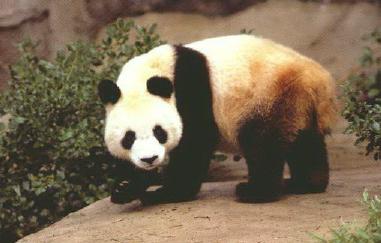
Giant Panda (China)
The Giant Panda Has a teddy-bear like appearance and organizations such as the World Wildlife Fund have helped win support for the Panda from people around the world. Despite international efforts to save the panda, fewer than 1,000 remain in the wild. Habitat destruction and poaching, combined with its low reproduction rate threaten the panda with extinction.SIZE Adult giant pandas range in body length from about 160 to 190 centimeters (64 to 76inches). Males are slightly longer than females, have stronger forelegs, and are 10 to 20 percent heavier. In the wild males weigh from 85 to 125 kilograms (190 to 275 pounds), while females
range between 70 and 100 kilograms (155 to 220 pounds). At birth, cubs weigh only 85 to 140 grams (3 to 5 ounces).

Giant Panda (China)
The giant panda is nears-sighted, but has a highly developed sense of hearing.It's diet consists of bamboo shoots, plant matter and small mammals. It is active from twilight to dawn. The panda is a Vanishing Species. (Photograph by Ron Kimball)


The giant panda lives alone except during the spring, when the males join the females to mate. Its diet consistes of at least 30 different species of bamboo stems and leaves. It walks with a steady rolling gait and holds its head low. (Phototograph by Ron Kimball)






LESSER OR RED PANDA
Status: VULNERABLE
Ailurus fulgens F. Cuvier, 1825CITES: Appendix II
HB 51-63.5cm; T 28-48.5cm; W 3-4.5kg (Nowak 1991)
The Lesser or Red Panda resembles a racoon in size and form, with reddish-brown fur and a ringed tail, and weighs on average around 5 kg. This mainly nocturnal species inhabits Himalayan temperate forests with bamboo thicket understories at relatively high altitudes (between 2,200 and 4,800 m), distributed from Nepal to China (Yunnan and Sichuan provinces), including Burma, Bhutan and India. The large scale habitat destruction is threatening the species, especially in the west of its range; forests are cut for wood and cleared for agriculture. It has been traded for its fur and the pet trade in the past. There are taxonomic difficulties in classifying the species, whether it is a raccoon, bear, or to be grouped separately with the Giant Panda. The Red Panda in China is sympatric with the Giant Panda, both feeding on bamboo (although a variety of other foods are eaten including some animals and fruits); if the habitat of the popular Giant Panda is conserved, this will also aid the conservation of the Red Panda (the Chinese government has created 12 reserves for the Giant Panda). It is protected in India and Nepal. In response to the scarcity of the species, an international breeding programme was initially established in more than 30 zoos; it is now a popular exhibit in zoos.
Sources:
Anon. (1991). Cut cheese production to save pandas. Oryx Vol. 25 (4), p 190. (refers to Conservation Biol. (1991) Vol. 5, pp. 196 - 202).
Johnson, K. G. (1990). Mystery of the Other Panda. In: International Wildlife. Vol.20, No.6. Nov/Dec 1990: 30-33.
Nowak, R.M. (1991). Walker's Mammals of the World, 5th edn. The John Hopkins University Press, Baltimore and London. 1629 pp.
Roberts, M. S. (1984). Ailurus fulgens. Mammalian Species. No. 222, Nov 1984: 1-8.

Thanks to Wendy Lee for the Red Panda Image



This Panda Ring site is owned
by Mark Hildebrandt.
Click for the
[
Previous]
[
Random]
[
Next Site]
[
Skip Next]
[
Next 5]
Click here for info on how to join
Panda Ring.


 bronco48@swbell.net
bronco48@swbell.net




|